2023 Lexus ES350 Changing Spare Tire User Manual
The Lexus ES350 2023 welcomes you to a world where luxury and performance meld together naturally. Every aspect of your driving experience is carefully considered in this exceptional sedan, even the requirement to change a spare tire in case of an unlucky flat. A spare tire made specifically for emergencies can be found in the trunk of your Lexus ES350 2023. This spare tire is securely kept in storage and is available for use as needed. Along with the spare tire, you’ll also discover all the equipment and tools you’ll need to make changing tires a breeze conveniently positioned nearby. It’s important to keep in mind that the spare tire on your Lexus ES350 2023 is only intended for short-term use and should be swapped out as soon as practical. Furthermore, it’s crucial to regularly check the air pressure in your spare tire to make sure it’s kept fully inflated and ready for use. Lexus ES350 2023 offers a well-designed system for changing your spare tire to ensure your safety and comfort while driving. You can successfully handle a flat tire situation and keep enjoying the exceptional driving experience that the Lexus ES350 2023 offers by comprehending the procedure, practicing beforehand, and following the instructions provided.
Spare Tire Replacement
If you have a Flat Tire
Your vehicle is equipped with a spare tire. The flat tire can be replaced with the spare tire. For details about tires:
WARNING
If you have a flat tire
Do not continue driving with a flat tire. Driving even a short distance with a flat tire can damage the tire and the wheel beyond repair, which could result in an accident.
Before jacking up the vehicle
Stop the vehicle in a safe place on a hard, flat surface.
Set the parking brake.
Shift the shift lever to P.
Stop the engine.
Turn on the emergency flashers.
Location of the spare tire, jack and tools
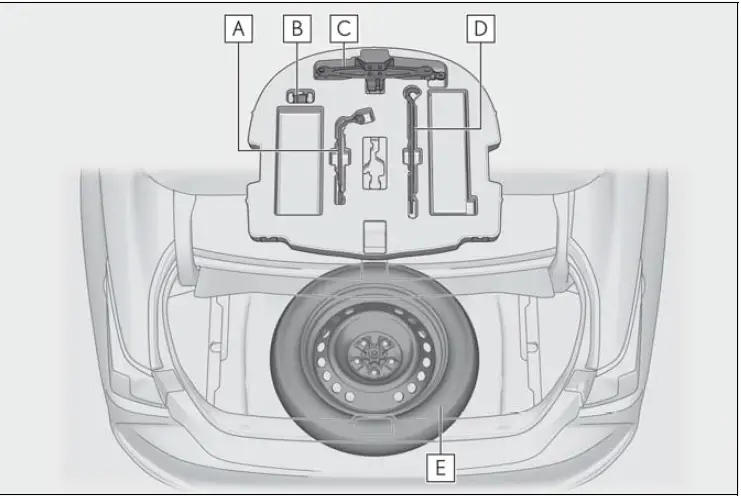
![]() Wheel nut wrench
Wheel nut wrench![]() Wheel lock key* (if equipped)
Wheel lock key* (if equipped)![]() Jack
Jack![]() Jack handle
Jack handle![]() Spare tire
Spare tire
*: Documentation relating to the wheel lock key, such as the registration and I.D. card, is inside the glove box.
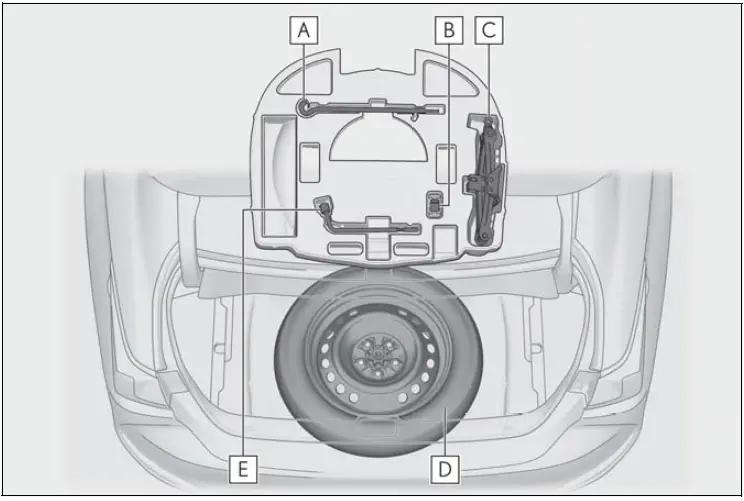
![]() Jack handle
Jack handle![]() Wheel lock key* (if equipped)
Wheel lock key* (if equipped)![]() Jack
Jack![]() Spare tire
Spare tire![]() Wheel nut wrench
Wheel nut wrench
*: Documentation relating to the wheel lock key, such as the registration and I.D. card, is inside the glove box.
WARNING
Using the Tire Jack
- Observe the following precautions. Improper use of the tire jack may cause the vehicle to suddenly fall off the jack, leading to death or serious injury.
- Do not use the tire jack for any purpose other than replacing tires or installing and removing tire chains.
- Only use the tire jack that comes with this vehicle for replacing a flat tire. Do not use it on other vehicles, and do not use other tire jacks for replacing tires on this vehicle.
- Put the jack properly in its jack point.
Do not put any part of your body under the vehicle while it is supported by the jack.
Do not start the engine or drive the vehicle while the vehicle is supported by the jack.
Do not raise the vehicle while some-one is inside.
When raising the vehicle, do not put an object on or under the jack.
WARNING
- Do not raise the vehicle to a height greater than that required to replace the tire.
- Use a jack stand if it is necessary to get under the vehicle.
When lowering the vehicle, make sure that there is no-one near the vehicle. If there are people nearby, warn them vocally before lowering.
Wheel lock nut (if equipped
When replacing tires on a vehicle with wheel lock nuts, use the following procedures to remove and install the wheel lock nuts. The wheel lock key is stored in the tray inside the luggage compartment. Always return the wheel lock key to its original position after use, so that it does not get lost.
NOTICE
Do not use an impact wrench. Using an impact wrench may cause permanent damage to wheel lock nut and wheel lock key. If in doubt about wheel lock application, contact your Lexus dealer.
Removal
For ease of removal, the wheel lock nut should always be the first one loosened.
- Place the wheel lock key on top of the wheel lock nut, turning until the wheel lock key and wheel lock nut patterns engage.
- Place the wheel nut wrench on the wheel lock key, and while applying pressure on the wheel lock key, loosen the wheel lock nut.
Installation
For ease of installation, the wheel lock nut should always be the last one tightened.
- By hand, Install a wheel lock nut on the wheel to be installed.
- Place the wheel lock key on top of the wheel lock nut, turning until the wheel lock key and wheel lock nut patterns engage.
- Place the wheel nut wrench on the wheel lock key, and while applying pressure on the wheel lock key, tighten the wheel lock nut to the recommended torque.
Taking out the jack
- Open the trunk.
- Pull the lever upwards when lifting the luggage mat up.
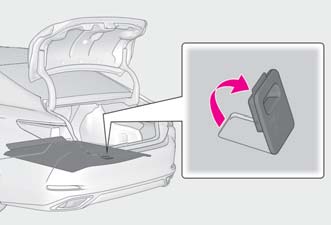
- The lever can be hooked on the edge of the trunk.
- Remove the jack.
Type A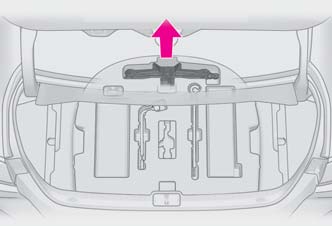
Type B
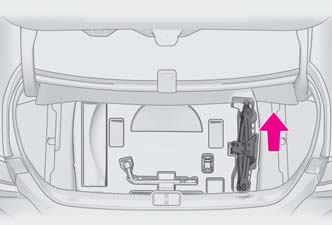
NOTICE
To prevent damage to luggage mat
When closing the trunk lid, do not leave the luggage mat lever hooked on the edge of the trunk.
Taking out the spare tire
- Remove the auxiliary box.
Type A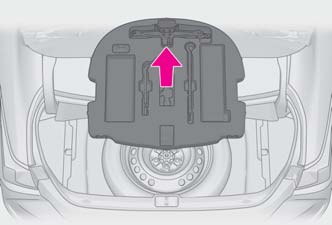 Type B
Type B
- Loosen the center fastener that secures the spare tire.
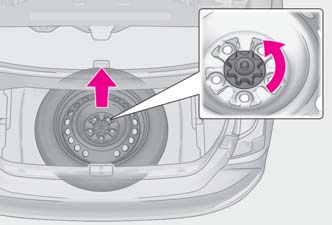
WARNING
When storing the spare tire
Be careful not to catch fingers or other body parts between the spare tire and the body of the vehicle.
Replacing a flat tire
- Chock the tires.
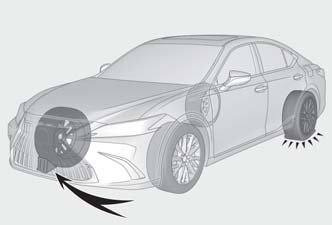
Flat tire Wheel chock positions Front left- hand side Behind the rear right-hand side tire Front right- hand side Behind the rear left-hand side tire Rear left- hand side In front of the front right- hand side tire Rear right- hand side In front of the front left- hand side tire - Slightly loosen the wheel nuts (one turn).
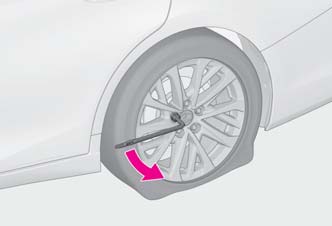
- Turn the tire jack portion A by hand until the notch of the jack is in contact with the jack point.
The jack point guides are located under the rocker panel. They indicate the jack point positions.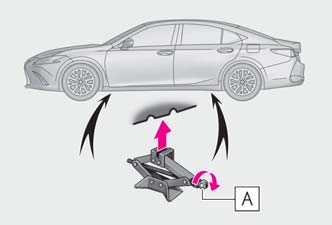
- Assemble the jack handle.
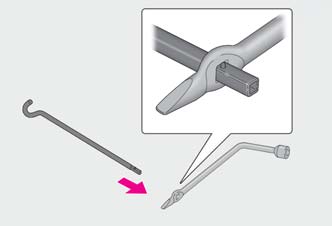
- Raise the vehicle until the tire is slightly raised off the ground.
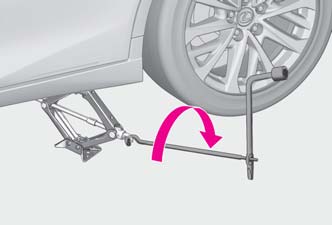
- Remove all the wheel nuts and the tire.
When resting the tire on the ground, place the tire so that the wheel design faces up to avoid scratching the wheel surface.
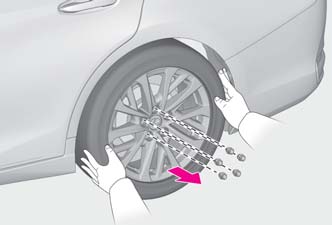
WARNING
Replacing a Flat Tire
- Do not touch the disc wheels or the area around the brakes immediately after the vehicle has been driven. After the vehicle has been driven the disc wheels and the area around the brakes will be extremely hot. Touching these areas with hands, feet or other body parts while changing a tire, etc. may result in burns.
- Failure to follow these precautions could cause the wheel nuts to loosen and the tire to fall off, resulting in death or serious injury.
- Never use oil or grease on the wheel bolts or wheel nuts.
Oil and grease may cause the wheel nuts to be excessively tightened, leading to bolt or disc wheel damage. In addition, the oil or grease can cause the wheel nuts to loosen and the wheel may fall off, causing a serious accident. Remove any oil or grease from the wheel bolts or wheel nuts. - Have the wheel nuts tightened with a torque wrench to 76 ft•lbf (103 N•m, 10.5 kg f•m) as soon as possible after changing wheels.
- When installing a tire, only use wheel nuts that have been specifically designed for that wheel.
- If there are any cracks or deformations in the bolt screws, nut threads or bolt holes of the wheel, have the vehicle inspected by your Lexus dealer.
- Do not attach a heavily damaged wheel ornament, as it may fly off the wheel while the vehicle is moving.
- Never use oil or grease on the wheel bolts or wheel nuts.
Installing the Spare Tire
- Remove any dirt or foreign matter
from the wheel contact surface.
If foreign matter is on the wheel contact surface, the wheel nuts may loosen while the vehicle is in motion, causing the tire to come off. - Install the spare tire and loosely tighten each wheel nut by hand by approximately the same amount.
Tighten the wheel nuts until the tapered portion A comes into loose contact with the disc wheel seat B.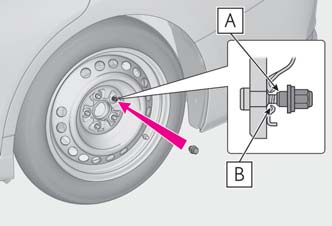
- Lower the vehicle.
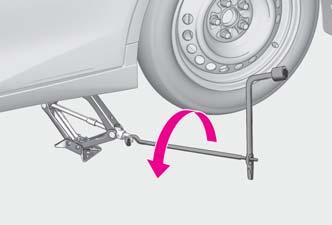
- Firmly tighten each wheel nut two or three times in the order shown in the illustration.
Tightening torque:
76 ft•lbf (103 N•m, 10.5 kgf•m) - Stow the flat tire, tire jack and all tools.
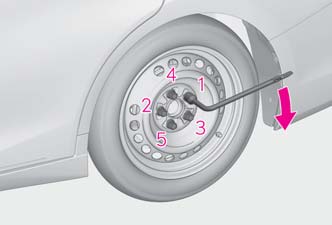
The Compact Spare Tire
- The compact spare tire is identified by the label “TEMPORARY USE ONLY” on the tire sidewall.
Use the compact spare tire temporarily, and only in an emergency.
Make sure to check the tire inflation pressure of the compact spare tire.
After completing the tire change
The tire pressure warning system must be reset. )
When using the compact spare tire
As the compact spare tire is not equipped with a tire pressure warning valve and transmitter, low inflation pressure of the spare tire will not be indicated by the tire pressure warning system. Also, if you replace the compact spare tire after the tire pressure warning light comes on, the light remains on.
When the compact spare tire is attached
The vehicle becomes lower when driving with the compact spare tire compared to when driving with standard tires.
If you have a flat front tire on a road covered with snow or ice (vehicles with 17-inch tires)
Install the compact spare tire on one of the rear wheels of the vehicle. Perform the following steps and fit tire chains to the front tires:
- Replace a rear tire with the compact spare tire.
- Replace the flat front tire with the tire removed from the rear of the vehicle.
- Fit tire chains to the front tires.
WARNING
When using the compact spare tire
- Remember that the compact spare tire provided is specifically designed for use with your vehicle. Do not use your compact spare tire on another vehicle.
Do not use more than one compact spare tire simultaneously.
Replace the compact spare tire with a standard tire as soon as possible.
Avoid sudden acceleration, abrupt steering, sudden braking and shifting operations that cause sudden engine braking.
When the compact spare tire is attached
The vehicle speed may not be correctly detected, and the following systems may not operate correctly:
- ABS & Brake assist
- VSC
WARNING
- TRAC
Dynamic radar cruise control with full-speed range
PCS (Pre-Collision System)
EPS
Adaptive Variable Suspension system (if equipped)
LTA (Lane Tracing Assist)
Panoramic view monitor (if equipped)
Lexus parking assist monitor
(if equipped)
Intuitive parking assist (if equipped)
Navigation system (if equipped)
BSM (Blind Spot Monitor)
AHB (Automatic High Beam)
Also, not only can the following system not be utilized fully, but it may even negatively affect the drive-train components:
- AWD system (if equipped)
Speed limit when using the compact spare tire
Do not drive at speeds in excess of 50 mph (80 km/h) when a compact spare tire is installed on the vehicle.
The compact spare tire is not designed for driving at high speeds. Failure to observe this precaution may lead to an accident causing death or serious injury.
After using the tools and jack
Before driving, make sure all the tools and jack are securely in place in their storage location to reduce the possibility of personal injury during a collision or sudden braking.
NOTICE
Be careful when driving over bumps with the compact spare tire installed on the vehicle
The vehicle becomes lower when driving with the compact spare tire compared to when driving with standard tires. Be careful when driving over uneven road surfaces.
Driving with tire chains and the com-pact spare tire
Do not fit tire chains to the compact spare tire.
Tire chains may damage the vehicle body and adversely affect driving performance.
When replacing the tires
When removing or fitting the wheels, tires or the tire pressure warning valve and transmitter, contact your Lexus dealer as the tire pressure warning valve and transmitter may be damaged if not handled correctly.
FAQ
The spare tire is typically located in the trunk of the Lexus ES350.
The Lexus ES350 usually comes with a compact spare tire, also known as a “donut” spare.
The vehicle should come with a jack, lug wrench, and other necessary tools for changing the spare tire.
To access the spare tire, open the trunk and look for a compartment or well in the trunk floor. Lift the cover to reveal the spare tire.
Yes, there are specific steps outlined in the owner’s manual that you should follow. It typically involves using the jack to lift the vehicle, removing the flat tire, and installing the spare.
Yes, it’s a good practice to engage the parking brake to ensure the vehicle remains stable while you change the tire.
The jack should come with instructions in the owner’s manual. Generally, you’ll place it in a designated lifting point under the vehicle and pump it to raise the car.
Yes, the lug wrench provided with the vehicle should be used to loosen and remove the lug nuts.
It’s essential to ensure you’re in a safe location away from traffic, and you should always use caution when working under the vehicle.
The recommended tire pressure for the spare tire is usually listed on the tire itself and in the owner’s manual. It’s typically higher than the standard tires.
Spare tires are not designed for long-distance or high-speed driving. They are intended for short trips to a service center to repair or replace the flat tire.
There may be a designated location or strap in the trunk to secure the flat tire in place.
After changing the flat tire, you should drive to a tire service center to have the original tire repaired or replaced and the spare tire returned to its storage location.
No, the spare tire is not meant to be a permanent replacement. It’s a temporary solution until the original tire can be repaired or replaced.
Detailed instructions for changing the spare tire can be found in the owner’s manual of your Lexus ES350. It’s essential to read and follow these instructions carefully to ensure safety and proper tire replacement.
Useful Link
View Full User Guide: Lexus ES350 2023 User Manual | Auto User Guide
Lexus ES350 2023 Driving Assist Systems User Manual


